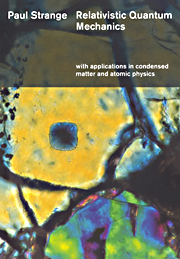Book contents
- Frontmatter
- Contents
- Preface
- 1 The Theory of Special Relativity
- 2 Aspects of Angular Momentum
- 3 Particles of Spin Zero
- 4 The Dirac Equation
- 5 Free Particles/Antiparticles
- 6 Symmetries and Operators
- 7 Separating Particles from Antiparticles
- 8 One-Electron Atoms
- 9 Potential Problems
- 10 More Than One Electron
- 11 Scattering Theory
- 12 Electrons and Photons
- 13 Superconductivity
- Appendix A The Uncertainty Principle
- Appendix B The Confluent Hypergeometric Function
- Appendix C Spherical Harmonics
- Appendix D Unit Systems
- Appendix E Fundamental Constants
- References
- Index
13 - Superconductivity
Published online by Cambridge University Press: 11 January 2010
- Frontmatter
- Contents
- Preface
- 1 The Theory of Special Relativity
- 2 Aspects of Angular Momentum
- 3 Particles of Spin Zero
- 4 The Dirac Equation
- 5 Free Particles/Antiparticles
- 6 Symmetries and Operators
- 7 Separating Particles from Antiparticles
- 8 One-Electron Atoms
- 9 Potential Problems
- 10 More Than One Electron
- 11 Scattering Theory
- 12 Electrons and Photons
- 13 Superconductivity
- Appendix A The Uncertainty Principle
- Appendix B The Confluent Hypergeometric Function
- Appendix C Spherical Harmonics
- Appendix D Unit Systems
- Appendix E Fundamental Constants
- References
- Index
Summary
Superconductivity was discovered by Kammerlingh Onnes (1911) (see Gorter 1964). It turned out to be one of the most difficult problems in condensed matter physics of the twentieth century. There were over 40 years between the discovery of the effect and the development of a satisfactory theory (Cooper 1956, Bardeen, Cooper and Schrieffer 1957). The theory was based on the insightful suggestion by Frohlich (1950) that under some circumstances electrons in a lattice could actually attract one another. The theory of superconductivity divides neatly into two parts. Firstly, there is the theory required to describe the mutual attraction of electrons to form Cooper pairs. Secondly, there is the theory that accepts pairing as a fact and then goes on to calculate observables and properties of superconductors. In this chapter we will be principally concerned with the latter aspects of superconductivity theory. We will start from the many-body theory developed in chapter 6 together with a pairing interaction to get to observables such as the superconducting energy gap, critical fields and temperatures, and to describe the electrodynamics of superconductors. On the whole, though, we will not reproduce superconductivity theory that appears in other textbooks. There are several good books on the non-relativistic theory of superconductivity.
- Type
- Chapter
- Information
- Relativistic Quantum MechanicsWith Applications in Condensed Matter and Atomic Physics, pp. 536 - 555Publisher: Cambridge University PressPrint publication year: 1998



